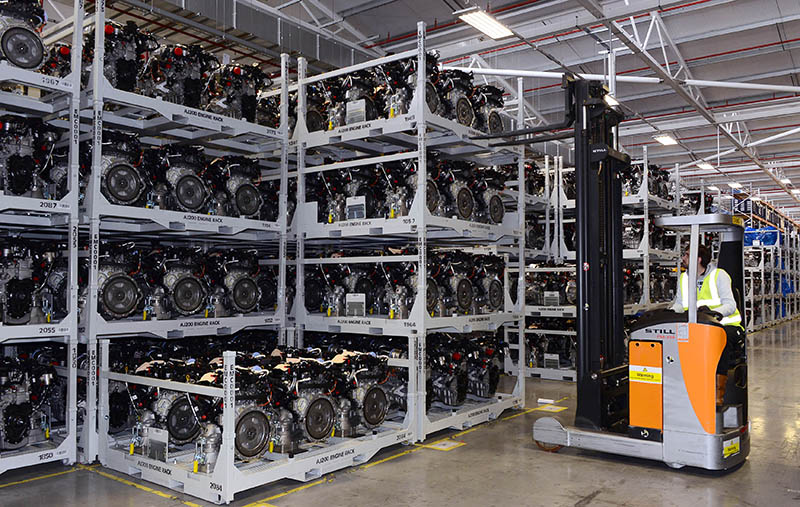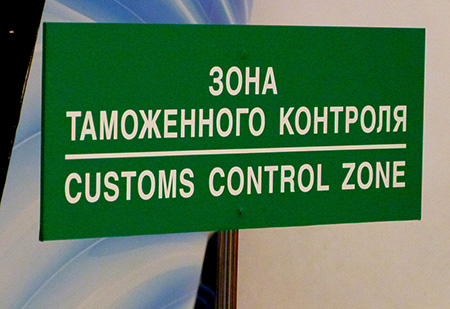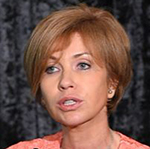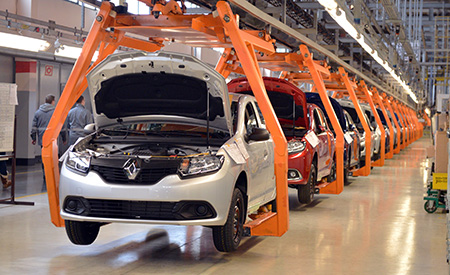 The industrial assembly policy that Russia’s government has been pursuing since 2008 initially looked to have played out quite well, encouraging the world’s leading automotive manufacturers to build assembly plants in the country. But after several economic crises, including a sharp devaluation of the rouble in 2014 and subsequent market declines, it became clear that the policy had at least one very important gap: while it included strict requirements about localisation in terms of tier one component suppliers, it did not do the same for tier two and tier three suppliers.
The industrial assembly policy that Russia’s government has been pursuing since 2008 initially looked to have played out quite well, encouraging the world’s leading automotive manufacturers to build assembly plants in the country. But after several economic crises, including a sharp devaluation of the rouble in 2014 and subsequent market declines, it became clear that the policy had at least one very important gap: while it included strict requirements about localisation in terms of tier one component suppliers, it did not do the same for tier two and tier three suppliers.
Despite localisation levels at assembly plants in Russia being between 40% and 60% around the end of 2014, when sales in the country were still more than 2.5m units per year, many domestically produced components were still being primarily assembled from imported parts and raw materials, leaving the national automotive industry’s dependence on imports less obvious, but still nearly absolute.
When the Russian currency collapsed in December 2014, it immediately resulted in an increase in the price of such imports, pulling profitability down at most assembly plants. In a bid to offset these losses, OEMs had no choice but to raise vehicle prices – which eventually became one of the main factors in wrecking domestic demand.
It wasn’t just foreign carmakers’ plants that were caught up in this trap, either. Russian vehicle-maker Avtovaz, producer of the Lada brand, was hit very badly, suffering enormous losses in 2014 and 2015 and being forced, following disruptions in the supply chain and attempts to stem those losses, to stop production at its plants several times over recent years.
Mind the gapRussia’s Industry Ministry, which has determined all the rules of engagement for the domestic automotive industry over the last decade, says lessons have been learned, which is why its industrial assembly agreement will not be extended in 2018.
Instead, the government plans to introduce Special Investment Contracts (SPICs), which will allow the regulator to stipulate new and more sophisticated requirements governing the assembly of vehicles in Russia.

Maya Sviridova, director of the industrial automotive cluster Autoprom North-West, says that in its current form, an extension of the industrial assembly agreement was impossible, primarily because it contradicts the obligations Russia took on in joining the World Trade Organization (WTO).
“Russia’s joining of the WTO and the expiry of the decrees on industrial assembly [in 2018] will end the preferential regime [of assembly plant operation contained in the industrial assembly agreement] with breaks on customs duties on imports of automotive components. To avoid rising costs, assembly plants have chosen to increase localisation and tighten cooperation with Russian suppliers,” says Sviridova, who is also deputy director of the Russian Association of Automotive Components.
The idea of the SPICs is that OEMs have taken on an obligation to invest money in their production capacities in Russia in various ways – ways that need to be discussed and agreed with the government individually. And where Russia’s industrial assembly agreements have offered preferential customs duties on components, SPICs will instead offer federal tax breaks.
For each OEM, the investment plan and the relevant tax breaks will be agreed individually, allowing the Industry Ministry more flexibility in regulating the automotive sector and also to introduce targets for localisation of tier two and tier three components.
“We should expect tightening requirements on localisation of products, including in the automotive industry, from the state agencies,” comments Wilhelmina Shavshina, head of the foreign trade regulation practice at DLA Piper.
She suggests that in establishing localisation requirements, the Industry Ministry supports the transfer of full-cycle production facilities to Russia, i.e., part-by-part manufacturing as opposed to knockdown parts and kits. “I believe such requirements in future may be applied to tier two and tier three suppliers for the use [by local assembly plants] of exclusively locally produced components and raw materials,” Shavshina says.
Strong resistanceIt is not certain that the Industry Ministry will be able to turn its plan into reality, as it faces strong resistance from the Ministry of Economic Development. Stronger domestic sales during 2017, which are on track to grow more than 10% compared to 2016, are still off a very low base, possibly ending the year at around 1.6m units – or just more than half of prior market peaks. OEMs have lambasted the idea of being forced to invest more money in localisation projects.
Marcus Osegowitsch, general director of Volkswagen Group Rus, in particular, has criticised SPICs. In statements to the Russian news outlet Gazeta, he suggested that while the tool would be useful in times of crisis, it would simply create an unlevel playing field for different market players in the meantime.
Carmakers with new projects in Russia will receive state subsidies per allocated investment amount, he points out – but OEMs that have operated in Russia for some time already will not be granted such aid for established production capacities or for localisation levels they have already achieved.
 "I believe [localisation] requirements in future may be applied to tier two and tier three suppliers for the use [by local assembly plants] of exclusively locally produced components and raw materials." - Wilhelmina Shavshina, DLA Piper
"I believe [localisation] requirements in future may be applied to tier two and tier three suppliers for the use [by local assembly plants] of exclusively locally produced components and raw materials." - Wilhelmina Shavshina, DLA Piper
“What we need is clearance and transparency in the market. We want equal operating terms for all market players,” Osegowitsch told Gazeta. “Only in this way can we achieve predictability and, respectively, continue our investments in Russia. If, however, the terms of operation are unequal, I will have to tell [Volkswagen’s] headquarters that the situation in Russia is vague and that it is unclear what will happen here after two, three or five years.”
Deputy minister of industry Alexander Morozov concedes that, for carmakers, it is hard to consider further investments in Russia, including in localisation of tier two and tier three components, but says the government has designed a solution that should make everyone happy.
“The Ministry, of course, understands that the return on investment for an assembly plant starts at a capacity of 200,000 units per year, while when it comes to the plant producing automatic transmissions, this figure is around 500,000 units per year,” he says. “We need quantity, which is why we have suggested automotive companies join forces and organise joint ventures to produce components.”
That proposal, which has already been made to Renault Nissan, Hyundai and Volkswagen, involves establishing joint capacities for the production of metal subcomponents that would be used at plants producing automatic transmissions. If carmakers agree to enter into such a joint venture, it could be included in their SPICs.
“At the start, they [carmakers] said they would not sit at the same negotiating table. However, as soon as more specifics on the planned state aid scheme were revealed, they changed their minds. Now, they are considering this proposal and negotiating with each other,” Morozov claims.
[mpu_ad]In 2017, a proposal to harmonise production of subcomponents for different OEMs in Russia was put forward by Avtovaz. The proposal suggested Russian carmakers and parts suppliers could unite in an alliance for the creation of a common components platform or at least the unification of key parts, including suspension and transmission parts as well as engines.
Harald Grübel, Avtovaz’s vice-president of engineering, mooted a country-wide alliance among all carmakers and the establishment of a joint procurement system that would lead to the development of shared components.
That would ultimately reduce the cost of vehicles as the alliance would be able to place bigger orders for components and therefore get a better price per part. Also, the establishment of such a system could significantly lower spending on logistics, as well as car assembly, testing and other operations, he said.
Grübel also says that the process of planning and cooperation among the different carmakers and OEMs could be organised and monitored by the government. Avtovaz has already entered into negotiations on the issue with some market participants, he says.
In the meantime, at least some manufacturers are actively pressing forward with localisation regardless of legislation. In November, for example, Mercedes-Benz hosted a supplier forum designed to entice local supply to the new plant it is building near Moscow. The plant is set to build the E-class sedan in 2019, followed by SUV models. The carmaker’s purchasing executives met with around 100 suppliers.
No small businessThe problem with producing subcomponents in Russia is not just about gaps in legislation, however: another issue is that there are few suppliers in Russia that can match the requirements of OEMs.
“Russia’s suppliers are assembling localised components mainly using imported subcomponents. The only way to solve this problem is to develop the automotive industry in the country,” comments Dmitry Mikhailov, director of Nissan Motor Manufacturing Rus.
“For example, look at the headlight. This is an expensive part and when it is manufactured locally, it significantly increases localisation of the entire finished vehicle,” he explains. “However, three out of the four main parts of the headlight are imported from Japan and only one is manufactured in Russia. So, the Russian share in the added value of the headlight is only around 20%, although it is declared to be a localised component,” he explains.
 Following problems with components, Avtovaz suggested an alliance between carmakers and suppliers to create a common parts platform
Following problems with components, Avtovaz suggested an alliance between carmakers and suppliers to create a common parts platformSuppliers of tier two and tier three components are usually small companies and in Russia’s automotive industry, that segment is virtually non-existent, Mikhailov adds.
Lilia Mokrousova, a spokesperson for the PSMA Group, the PSA-Mitsubishi joint venture in Russia, confirms that there are some common concerns about subcomponents supply in the country.
“It is quite hard to find [in Russia] localised suppliers of electrical and electronic components, as well as competitive machining operation workshops,” she says. “In spite of this, PSMA Rus is introducing best practice in raw materials import replacement, and helping to develop its second and third tier suppliers. At the moment, the greatest vertical integration has been achieved in the details of the interior, exterior and car body.”
Shrinking sales in Russia’s automotive market have also had a negative impact on component manufacturers. In particular, in 2015, when the economic crisis in Russia reached its peak, several projects for the production of subcomponents were put on hold, including a new plant plant in St Petersburg from Unipres, a Japanese pressed parts supplier.
“Localisation of second and third tier components is taking place slowly compared to first tier components, because these are more compact items, so logistics is not too expensive; on the other hand, these components are often high-tech products, so localisation requires significant investment,” says Andrey Kosov, chairman of the Automotive Components Committee at the Association of European Business.
“At the same time, return on investment [on subcomponents projects] is achievable only at high production volumes of the same type. On the Russian market, however, those volumes are rather finely segmented,” he adds.
Russian logistics providers suggest assembly plants in the country are increasingly sourcing tier two and tier three components from local suppliers, however.
[related_topics align="right" border="yes"]“The localisation level is growing, as OEMs with production sites in Togliatti, Izhevsk, Tatarstan and the Leningrad Oblast have started to use competitive bidding procedures for incoming logistics of components. Within these tenders, internal flows in Russia account for 30% of all deliveries,” says Natalia Zakirova, head of sales at Gefco Russia.
Military invades the supply chainMuch depends on the cost per unit in combined production volumes, though this has been falling in Russia’s automotive components industry in recent years, Sviridova suggests. It is also not such a big consideration for military manufacturing operations, who are getting more actively engaged in the production of automotive components.
In a new trend in Russia’s automotive industry, a growing number of companies from the military production segment are applying for so-called ‘conversion’ to allow them to start manufacturing civilian products. The move stems from a shrinking number of new orders by the Russian military, which has forced them to seek other opportunities in non-military projects.
"The unstable exchange rate and a clear tendency towards devaluation makes the import of components and materials both expensive and risky. Production of automotive components from Russian materials by local second and third tier suppliers will improve the profitability of both tier one component producers and carmakers." - Tatiana Hristova, IHS Markit
“So far, there are only a few [military companies producing automotive components], but the number has recently started growing strongly. In particular, companies like Okeanpribor and Bipitron have recently started supplying assembly plants with printed circuit boards and other electronic components for the production of finished vehicles,” Sviridova says.
It is too early to say whether these military suppliers will gain significant ground in the automotive market, however – not least as such work is likely to generate less revenue than their core business in defence and weapons.
“Production of automotive components is a low-margin business; the profit per unit does not correspond with the basic parameters of the defence industry,” confirms Sviridova. “Additionally, carmakers have very high quality requirements, not only in regards to the products themselves, but also in terms of the management and organisation of the production process. This, in turn, requires some effort, time and money – so not every company is up to it.”
Critical balance While greater localisation of tier two and tier three components will depend on meeting government requirements and achieving the right level of profitability, such supplies will be critical to the existence of Russia’s automotive industry, suggests Tatiana Hristova, IHS Markit Global European light vehicle forecast manager for central and east Europe.
 Although Russian military companies are starting to enter the automotive supplier market, margins may be too low for many
Although Russian military companies are starting to enter the automotive supplier market, margins may be too low for many“The unstable exchange rate and a clear tendency towards devaluation makes the import of components and materials both expensive and risky,” she says. “Production of automotive components from Russian materials by local second and third tier suppliers will improve the profitability of both tier one component producers and carmakers.”
At the same time, she admits, investments in components production will only be made on the basis of production volumes which, in turn, can only be achieved via growth in the local Russian market or growth in exports of vehicles to other countries.
“Poor development of export logistics and a rather modest growth outlook for the Russian finished vehicles market itself – IHS Markit currently expects growth in sales of finished vehicles to reach previous highs of 3m units only in 2028 – will not allow some suppliers to increase production to a level where further investment in localisation will be of real value,” she cautions.
On the other hand, if production of more tier two and tier three components is not localised, it is likely to affect the profitability of finished vehicles and have a negative impact on the attractiveness of investing in the automotive industry in Russia as a whole, she warns.
The message is clear: get local in Russia or, quite likely, pack up shop.
Topics
- Association of European Business
- Autoprom North-West
- Avtovaz
- Bipitron
- DLA Piper
- Europe
- features
- Gefco Russia
- Hyundai
- IHS Markit
- Inbound Logistics
- Mercedes-Benz
- Mitsubishi
- Nissan
- Nissan
- Nissan Motor Manufacturing Rus
- Okeanpribor
- Policy and regulation
- PSMA Group
- Renault-Nissan
- Russian Association of Automotive Components
- Russian Federation
- Suppliers
- Supply Chain Planning
- Unipres
- Volkswagen
- Volkswagen Group Rus


























![Global[1]](https://d3n5uof8vony13.cloudfront.net/Pictures/web/a/d/s/global1_726550.svgz)









